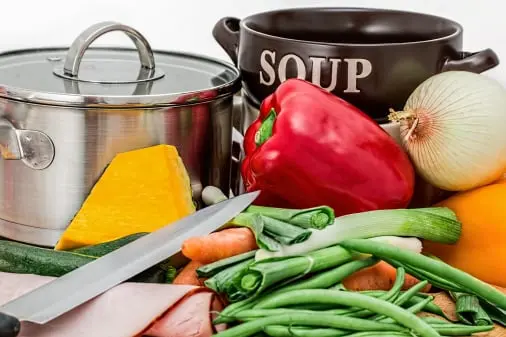Food service traceability app:
Food service traceability app for processors & value adders of fresh produce, fresh cuts, salad, coleslaw, potato chips. Manages entire food service business operations & traceability. Food service recall and audit traceability.

Food service Traceability during production & packing
View Traceability App Specifications.
FOOD SERVICE TRACEABILITY
Food traceability is the ability to follow the movement of a food product and its ingredients through all steps in the supply chain, both backward and forward. Traceability involves documenting and linking the production, processing, and distribution chain of food products and ingredients. In the case of a foodborne illness outbreak or contamination event, efficient product tracing helps government agencies and those who produce and sell food to rapidly find the source of the product and where contamination may have occurred. This enables faster removal of the affected product from the marketplace, reducing incidences of foodborne illnesses.
Existing FDA regulations require much of the food industry to establish and maintain records that document one step forward to where food has gone and one step back to its immediate previous source. These requirements establish baseline traceability recordkeeping throughout much of the food system, but these records often prove insufficient to effectively and rapidly link shipments of food through each point in the supply chain. In addition, these existing FDA traceability requirements do not apply to farms and restaurants, meaning that a large part of the supply chain is excluded from keeping these important traceability records. Simply put- the U.S. lacks a harmonized system of traceability from farm to fork that is universally understood and utilized. This means that during an outbreak investigation, our ability to rapidly track and trace food is often impeded by insufficient data identifying a food as it moved through its supply chain. A modern, coordinated approach to traceability that can be used and understood throughout all stages of the food supply chain will go further to reduce foodborne illness, build consumer trust, and avoid overly-broad recalls.
FSMA and Traceability
The FDA Food Safety Modernization Act (FSMA) addresses this need for rapid and effective tracking and tracing of foods. FSMA section 204, Enhancing Tracking and Tracing of Food and Recordkeeping, instructs the FDA to develop additional recordkeeping requirements for certain foods. Section 204 has three major requirements:
FDA must establish pilot projects in coordination with the food industry to explore and evaluate methods and appropriate technologies for rapid and effective tracking and tracing of foods.
These pilot projects were completed, and in March 2013 FDA released a report containing the findings. In addition, in November 2016, FDA issued a Report to Congress that described the findings of the pilot projects and that also included the agency’s recommendations for improving the tracking and tracing of food, as required by section 204 of FSMA.
FDA is required to designate foods for which additional recordkeeping requirements are appropriate and necessary to protect the public health.

Food service packhouse hygiene checklist for food safety
The FDA published a draft Food Traceability List for public comment.
FDA must publish a notice of proposed rulemaking to establish such additional recordkeeping requirements for the designated foods, to help in tracing such foods.
The agency published the Proposed Rule, “Requirements for Additional Traceability Records for Certain Foods” (Food Traceability Proposed Rule).
On July 13, 2020, the FDA released the Blueprint for the New Era of Smarter Food Safety. The blueprint outlines the FDA’s vision to enhance traceability, improve predictive analytics, respond more rapidly to outbreaks, address new business models, reduce contamination of food, and foster the development of stronger food safety cultures. Although the FSMA 204 rulemaking is limited to only certain foods, the blueprint identifies it as a foundational first step on the path to promoting tech-enabled end-to-end traceability for all foods. The proposed rule, when finalized, would establish a standardized approach to traceability recordkeeping, paving the way for industry to adopt, harmonize, and leverage more digital traceability systems in the future.
Standardizing traceability in foodservice bakery and manufacturing industry
GS1 strives to unify traceability efforts for improved efficiency and food safety.
Standardizing traceability in foodservice bakery and manufacturing industry
A robust food safety program will include advanced traceability systems that align with other businesses up and down the supply chain. As the foodservice industry seeks to implement improved connectivity to improve recall readiness, more producers continue to look for solutions that will offer strong traceability.
In order to learn more about how current technology platforms can help with these efforts, we reached out to Liz Sertl, senior director, community engagement, GS1 US, Ewing Township, NJ.
GS1 is a neutral, global collaboration platform that brings industry leaders, government, regulators, academia, and associations together to develop standards-based solutions to address the challenges of data exchange. GS1 features local member organizations in 115 countries, over two million user companies, and 6 billion transactions every day.
Douglas J. Peckenpaugh: How does GS1 fit into the FDA’s “New Era of Smarter Food Safety” initiative?

Food service Traceability management best practices
Liz Sertl: The FDA released its “New Era of Smarter Food Safety Blueprint” in July 2020. This initiative outlines a commitment to dramatically improve food safety and calls for a new, technology-driven approach to modernize the food system by upgrading stakeholders’ ability to track and trace products throughout the supply chain.
GS1 Standards govern processes to “identify, capture, and share” product and location data across the supply chain. They can be used to populate data elements specified by the New Era blueprint and the FDA’s “FSMA Proposed Rule for Food Traceability,” addressing Section 204(d) of FSMA. The relevant GS1 Standards include:
GS1 Global Trade Item Number (GTIN), used to uniquely identify a product
EPCIS (Electronic Product Code Information Services), a data sharing standard for recording events like shipping, receiving, etc.
GS1 Global Location Numbers (GLNs), denoting specific locations where those transactions occur
DJP: Why is GS1 the right solution for food/foodservice industry distribution (including temperature/controlled warehousing/cold storage)?
LS: GS1 Standards can be leveraged in a variety of different traceability solutions to assure data consistency and interoperability. The standards themselves are not a solution but a key component in any solution that can be used system-wide for improving traceability. For example, EPCIS (Electronic Product Code Information Services) is a data sharing standard that provides more detail on critical tracking events such as the state of the item (e.g., saleable, expired, or in transit) or current conditions like temperature. Having real time access to this information across the supply chain can mean safer food, less waste, and higher quality products being sold on shelves and served in restaurants.
DJP: What are some of the top reasons why a processor and/or distributor of low-moisture bakery or snack producer (breads, buns, rolls, tortillas, crackers, pretzels, etc.) serving the foodservice market should invest in a robust traceability system?
LS: There are several system-wide benefits of using global standards to provide traceability in the supply chain. One of these is recall readiness. Track and trace capabilities enable fast, accurate removal of products from distribution when needed; GTINs and GLNs provide the data for accurately identifying and finding those products. In addition, product transparency that is afforded by encoding product identifiers and attributes in a barcode, using GTINs, enables the robust product information that consumers are looking for. This is helpful for retailers deciding what products to buy in order to satisfy their customers. Improved visibility allows supply chain partners to accurately identify products and their locations in real time, for better ordering and inventory control. Especially in a world where product shortages are not uncommon, every stakeholder needs up-to-the-minute visibility into product availability and delivery forecasts.

Food service Supplier Traceability Management
LS: It all begins with unique identification. The first step is to ensure that products are appropriately marked with a barcode containing a GS1 GTIN, a unique number issued by GS1 US that identifies a single product in the supply chain. The GTINs are assigned by the product manufacturer, and should be integrated within the receiver’s product masters, cross-referencing them with existing product numbers. Receivers should request GS1 barcodes on all products, cases and pallets from suppliers, along with Advance Ship Notices (ASNs) and Serial Shipping Container Codes (SSCCs) on all pallets. Distributors may also need a GS1 Company Prefix (obtained from GS1 US) so they can assign Global Location Numbers (GLNs) to their locations. This will require an assessment of which entities and locations need to be identified to enable complete traceability.
he Three Drivers of Food Traceability Changes
Prior to the outbreak of coronavirus disease (COVID-19) and its ensuing supply chain challenges, 2020 was shaping up to be arguably the most future-focused year in food safety. Given promising developments in emerging technology and the forthcoming “New Era of Smarter Food Safety” blueprint from the U.S. Food and Drug Administration (FDA), the industry still stands ready to take action to drive out wasteful practices that have plagued the food supply chain for years and take action to achieve supply chain visibility.
Alongside these developments, the consumer is continuing to exert more influence on supply chain practices, demanding not just safer food but data as proof to support marketing claims like organic, clean, or locally sourced. This is expected to increase in importance as consumers, weary from the COVID-19 crisis, may become even more interested in transparency and building trust with the brands that they relied on to get them through challenging times. The very idea that brands and retailers would be willing to make more information available is building trust.
The year that has ushered in a new decade, 2020, already feels like a turning point for the food supply chain. Let’s expand on these top three drivers of food traceability changes—regulatory activity, technology impact, and consumer-centricity—in the year ahead and reveal the opportunities that lie in each for food safety professionals to make an impact.
Regulatory Activity: The New Era of Smarter Food Safety and FSMA
FDA’s broad initiative called “The New Era of Smarter Food Safety” was unveiled in the spring of last year. It signifies renewed energy around food traceability and inspired a number of supportive comments from various food industry organizations before the comment period closed late last year. It outlines a modern approach, building on what was set forth in the Food Safety Modernization Act (FSMA) in 2011 while also recognizing how the supply chain has changed since then.
The plan calls for collaboration and focus in four areas: tech-enabled traceability and foodborne outbreak response: smarter tools and approaches for prevention; new business models and retail modernization; and food safety culture. With obvious similarities in each of the project’s quadrants, simply put, the plan is to leverage what already works to trace food, weed out the outdated paper-based processes that hinder traceability and peer around the corner to explore what can enhance foundational traceability processes.
GS1 Standards are already playing a major role in facilitating end-to-end traceability, as they enable supply chain visibility. Data that is structured, collected and shared in a consistent manner is more likely to be effective to solve traceability challenges, and is essential to helping all supply chain partners see where product has gone, and continuously communicate key data used in a recall or withdrawal.
The food industry stakeholders that already run systems based on GS1 Standards are likely to be the ones best prepared for future traceability requirements. Food safety professionals should be aware of a broader push for education about traceability at the farm level this year, as well as a call for digital record keeping--an anticipated requirement of future FSMA rules. “One up, one back” traceability is no longer good enough. It’s time to implement more automation for greater efficiency and consumer protection.
Technology Impact: An Enhanced Understanding of Blockchain
Blockchain supports food safety initiatives and can play a critical role in creating more transparency in the supply chain to build consumer trust. The use of blockchain can lead to more accountability in the supply chain by creating an immutable ledger or audit trail of product events and transactions.
Many industry leaders are more strategically planning to use blockchain this year after learning from pilot programs over the past two years. Supply chain use cases are being evaluated for the criticality of the role blockchain played to solve a particular challenge. Many are asking “Did blockchain give us something better than what we’re using today?” In some cases, the answer is yes and in some, the answer is no.
Either way, the companies that pilot blockchain usually end up learning more about their systems’ ability to share data externally, as well as their trading partners’ data sharing capabilities. Blockchain programs have surfaced data quality issues and inconsistencies that need to be addressed. In fact, a recent Gartner study concluded that from 2020 through 2022, 80 percent of supply chain blockchain initiatives will remain at a pilot stage instead of emerging into broad-based applications. The researchers point to the fact that many supply chain use cases still rely on events that are stuck in the “analog world,” such as events and data occurring across physical products, packaging layers, and transportation assets.
Blockchain can do a lot of things but it can’t magically make your data ready for the permanence of an immutable ledger or give you instant supply chain visibility. This year, look for a more thoughtful approach to blockchain adoption that incorporates global data standards and more stringent data governance to ensure wise investments are made.
Consumer-Centricity: Closing the Gap
A recent study by Deloitte found that over the last two years, more than 60 percent of consumers increased spending on the fresh food category. Other research from the Center for Food Integrity found that 65 percent of consumers want to know more about where their food comes from.
As consumers continue to diversify their diets, it will be increasingly important for food brands and retailers to provide trustworthy information, which leads to peace of mind. By prioritizing food traceability, the industry can work together to close the gap between consumer demand for fresh, healthy food and the industry’s ability to meet that demand with assurance of safety.
In the year ahead, look for increased collaboration between trading partners to more easily identify the location where a product was harvested and produced. This will help them complete the full picture of traceability for consumers. A key data standard that can help create efficiencies here is the Global Location Number, which uniquely identifies a company’s physical locations such as a store or a warehouse. This number can be universally accepted in trading partner systems and is a key part of traceability programs because they allow for more precise recording and sharing of supply chain events.
By keeping an eye on these key drivers of change, the food industry can be well-prepared to navigate through an increasingly disruptive year. Now more than ever, continued collaboration between supply chain partners is critical to fuel the journey.
FOOD SERVICE TRACEABILITY MANAGEMENT
Food Chain Traceability
All players in the food chain want to demonstrate their commitment to food quality and safety, and assure the reliability of their suppliers. A food chain traceability standard helps map and document a product’s history, creating trust and confidence toward consumers.
A food chain traceability standard is applicable to document the history or identify the location of a product, or the relevant components, either inside an individual company or in a coordinated food chain system. This can help a company provide internal logistical and quality related information, which can improve efficiency (e.g. appropriate stock rotation). Upstream, it can provide credibility to a product with undetectable quality attributes.
A safe food product is the result of all the processes and handling activities carried out throughout the entire food chain. A proper traceability system can help create a feedback loop to improve product quality, conditions and delivery, optimising related costs. It also helps provide transparency in distribution routes and improve supply chain efficiency and trading partner collaboration.
Furthermore, requirements for product identification, which are applicable in the case of non-GMO (Genetically Modified Organisms) products, organic products, or certification of product origin, demand a secure product identification system and reliable retrieval of related product information. Last but not least, in the case of an incident, an efficient, fast, and precise withdrawal or recall system is needed.